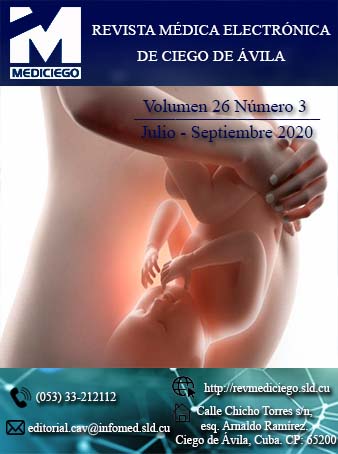Characteristics of the suicide attempt in adolescents from Ciego de Ávila
Keywords:
Intento suicida, suicidio, lesiones autoinfligidas, conducta suicida, adolescenteAbstract
Introduction: the expressions suicide and suicide attempt refer to the desire to seek death, which is achieved in the first case and not in the second. Suicide is a global problem that has an impact on adolescence.
Objective: to describe the characteristics of the suicide attempt in adolescents between 10 and 18 years of age in the Ciego de Ávila province.
Methods: a descriptive observational cross-sectional study was carried out between January 2018 and June 2019. The universe consisted of 192 adolescents between 10 and 18 years old, of which 176 were selected by intentional non-probabilistic sampling. The information was obtained from the medical records. The ethical precepts were fulfilled.
Results: among the studied adolescents the female sex (82,95 %), the ages between 15 and 18 years (67,61 %), urban origin (82,39 %), depression and dysfunctional family (91,47 % respectively) as risk factors. Psychotropic drugs were the most commonly used toxins (59,09 %) in suicide attempts and the oral route was the most frequent (92,04 %).
Conclusions: the suicide attempt prevailed in adolescents between 15 and 18 years of urban origin. Depression and dysfunctional family were the most frequent risk factors. Psychotropic drugs were the most used poisons and the oral route was the most commonDownloads
Published
How to Cite
Issue
Section
License
Copyright (c) 2021 Omarys Loyola Cabrera

This work is licensed under a Creative Commons Attribution-NonCommercial 4.0 International License.
Those authors who have publications with this journal accept the following terms of the License CC Attribution-NonCommercial 4.0 International (CC BY-NC 4.0):
You are free to:
- Share — copy and redistribute the material in any medium or format for any purpose, even commercially.
- Adapt — remix, transform, and build upon the material for any purpose, even commercially.
The licensor cannot revoke these freedoms as long as you follow the license terms.
Under the following terms:
- Attribution — You must give appropriate credit , provide a link to the license, and indicate if changes were made . You may do so in any reasonable manner, but not in any way that suggests the licensor endorses you or your use
- No additional restrictions — You may not apply legal terms or technological measures that legally restrict others from doing anything the license permits.
The journal is not responsible for the opinions and concepts expressed in the works, which are the exclusive responsibility of the authors. The Editor, with the assistance of the Editorial Committee, reserves the right to suggest or request advisable or necessary modifications. Original scientific works are accepted for publication, as are the results of research of interest that have not been published or sent to another journal for the same purpose.
The mention of trademarks of specific equipment, instruments or materials is for identification purposes, and there is no promotional commitment in relation to them, neither by the authors nor by the editor.






















